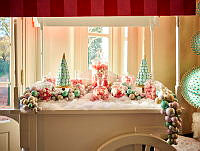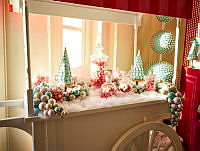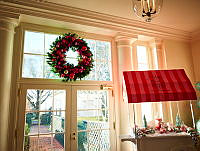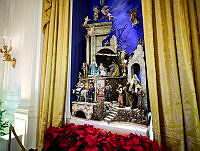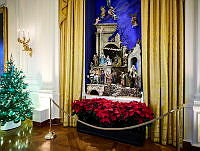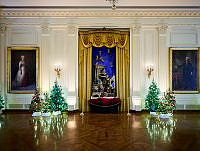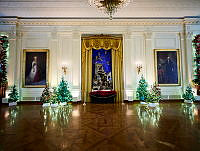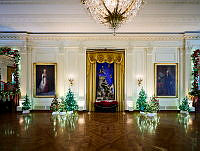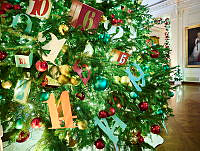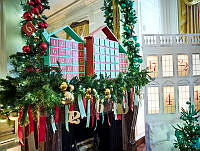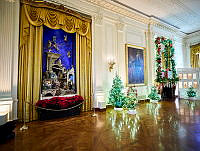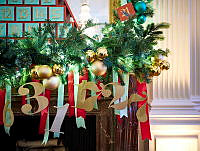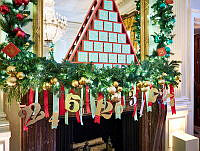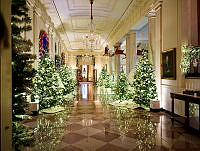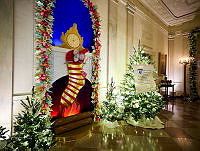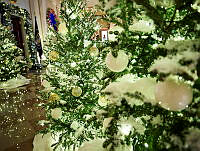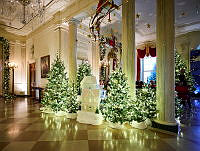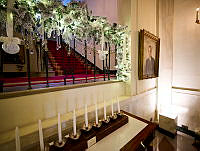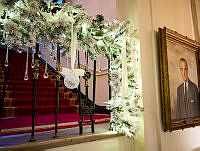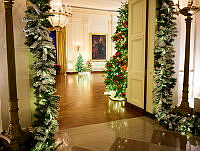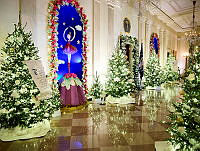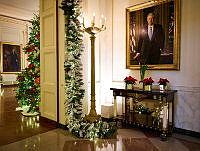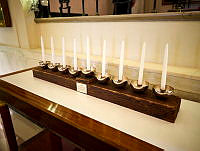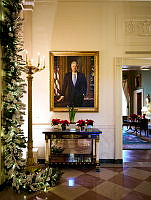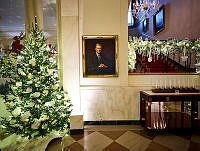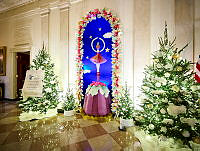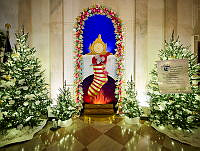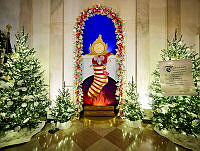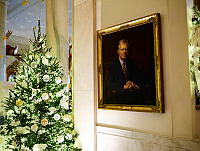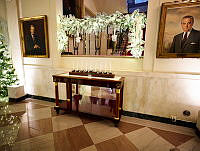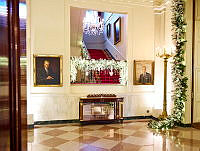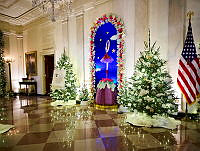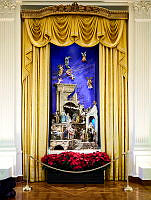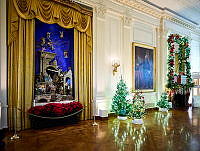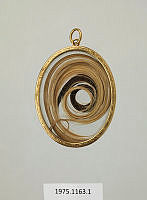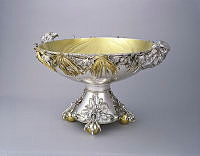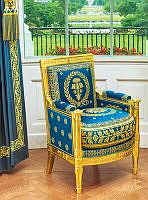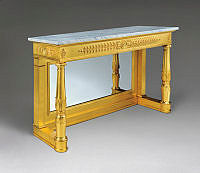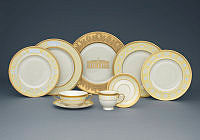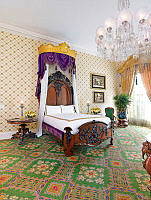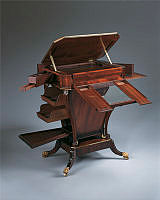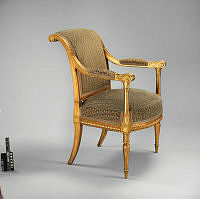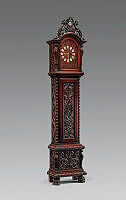The White House Collection: The Beaux Arts Furnishing of 1902
Copyright © White House Historical Association. All rights reserved under international copyright conventions. No part of this article may be reproduced or utilized in any form or by any means, electronic or mechanical, including photocopying, recording, or by any information storage and retrieval system, without permission in writing from the publisher. Requests for reprint permissions should be addressed to books@whha.org

The large Bohemian glass chandeliers hung in the East Room in 1902 were among the new lighting fixtures described by architect Glenn Brown as the "most artistic that have been designed in the country." These chandeliers seen in this 1904 photograph remain in the East Room today.
White House CollectionOne of the principal goals that governed the architectural changes made to the White House in 1902 by McKim, Mead & White—to refurnish the interior of the building in harmony with its exterior architecture—was adhered to in furnishing the State Rooms. The eclecticism of the variety of forms and styles of furniture and other decorative objects designed and made for the White House was typical of the work of Beaux Arts architects such as Charles F. McKim, who had studied at the Ecole des Beaux-Arts in Paris and were influenced by European precedents in architecture, art, and design. They were inspired to copy historical objects in a variety of French and English neoclassical styles as well as those of late-18th- and early-19th-century America—forms and styles they believed corresponded to the architectural design of the White House as influenced by mid-18th-century English and Irish Georgian domestic architecture. The rooms were stripped of the accumulations of 19th-century furnishings that represented a century of White House history.
The new White House interiors and furnishings reflected the widespread interest in the creation of a national identity through designs that had been developing in the United States since the 1876 Philadelphia Centennial Exposition. Americans looked back to the nation’s origins and an idealized past and sought representative antiques or reproductions of furnishings from the earliest periods of the country’s history. Colonial Revival furnishings and copies of English and French neoclassical styles were selected for rooms at the same time that a growing emphasis on lighter spaces and a reaction away from pattern in wallpaper, fabrics, and carpets—and from a certain busyness and “artistic” clutter in the number and arrangement of objects—were changing American interiors. The novelist Edith Wharton, a friend of Charles McKim and cousin of President Theodore Roosevelt’s wife Edith, had collaborated with architect and designer Ogden Codman to write The Decoration of Houses (1896), an influential book that stressed the important relation ship of furnishings to a room’s architecture and of each room to others in a house. These ideas had been incorporated into earlier houses designed by McKim, were evident in the firm’s White House work.
At the request of President Theodore Roosevelt and First Lady Edith Roosevelt, planning for changes to the interior began in the spring of 1902, but no orders were placed until Congress appropriated funds for the entire renovation and executive office construction project. At the end of June, $80,000 was set aside for furnishings and new lighting fixtures for the State Rooms, family spaces, and the new Executive Office Building, all to be designed, manufactured, and installed in less than six months, as President and Mrs. Roosevelt wanted the house ready for the winter social season. (The increased costs for electrical wiring and new heating reduced the funds available for furnishings and decoration throughout the family quarters.) During the summer of 1902, while the Roosevelts were at Sagamore Hill, their Oyster Bay, Long Island, home, Edith Roosevelt reviewed McKim’s proposals for paint colors, furniture, wall coverings, and fabrics. In November, the Roosevelt family moved back into their living quarters. The state ceremonial rooms were unveiled at a dinner for the cabinet in mid- December.
Two rooms have retained their 1902 furnishings for a century—the State Dining Room and the East Room.
The new furnishings, which remain in the White House collection, came from firms that McKim had worked with on previous projects. The Boston firm of A. H. Davenport, one of the leading manufacturers of furniture in Colonial Revival styles, received the commission for the State Dining Room, Family Dining Room, the Green Room, and rooms in the family quarters that were converted from office spaces to bedrooms and sitting rooms. The fashionable New York decorating and manufacturing firm of Leon Marcotte Company, in business since the 1870s, produced furnishings in the Louis XVI revival and French Empire styles for the major reception rooms on the state floor—the East Room and the Blue Room.12
Two rooms have retained their 1902 furnishings for a century—the State Dining Room and the East Room. The enlarged State Dining Room, with its richly carved oak walls hung with Flemish tapestries, gave the appearance of an English men’s club. Stanford White designed for it William and Mary and Queen Anne style chairs and three mahogany serving or console tables with massive carved eagle pedestals and marble tops modeled after Italian tables in his own New York home. For the East Room, Marcotte manufactured carved and gilded window cornices, benches in various sizes covered in silk velours, and four marble top console tables (presently in storage), all in the Louis XVI revival style of the room’s white enameled wood paneling. Its architectural details had been adapted by McKim from the Chateau de Compiegne north of Paris.
McKim turned to France, too, for the Blue Room. The gilded suite of French Empire furniture that had been purchased for the room in 1817 had long since been removed and dispersed at auction. Marcotte copied, instead, a painted and gilded suite of French furniture of the Napoleonic period from Compiegne and made small, shieldback chairs derived from English designs, all painted white with gilt trim to imitate bronze mounts. Marcotte also executed the interior decoration selected by McKim for the Blue Room, covering the walls in a dark blue silk rep with a gold Greek key border. Gilded bronze andirons in the Egyptian revival style with reclining sphinx copied from early-19th-century French chenets were supplied by Marcotte for the Blue Room and Red Room.

The enlarged State Dining Room, with its richly carved oak walls hung with Flemish tapestries, gave the appearance of an English men's club. The mahogany console tables with carved eagle pedestals and the Queen Anne style chairs were made by A.H. Davenport and remain in the State Dining Room.
Library of CongressThe Family Dining Room furniture was produced by A. H. Davenport in Chippendale and Sheraton styles, all made from special designs that were larger in scale and with different details than original pieces of the late 18th and early 19th centuries. The Colonial Revival mahogany bedroom furniture made for the family quarters imitates other early-19th-century American styles. In the Green Room with its dark green velour walls, Mckim installed a large, caned-back sofa and chairs derived from early-19th-century English and French designs, all painted white and with tapestry upholstery.
In contrast, the Red Room received heavily stuffed and tufted, comfortable red damask upholstered sofas and chairs, retaining a more late- 19th-century Victorian appearance than the other state rooms. White painted shield-back chairs similar to those in the Green Room stood out against the dark red velvet-covered walls.
Eleven years after the White House was first wired for electricity, the contract for new lighting fixtures was awarded to Edward F. Caldwell and Company of New York at the suggestion of McKim, Mead & White, who approved all the designs and supervised the work. Caldwell, in business since 1895, was a prominent designer of lighting fixtures who had worked on earlier McKim, Mead & White projects. Washington architect Glenn Brown, superintendent of the White House project, observed that the fixtures made for the White House were probably the “most artistic that have been designed in the country.”3 Caldwell was paid $23,588 for three large Bohemian glass chandeliers (East Room), a silver chandelier and eight silver wall sconces (State Dining Room), a gilded metal chandelier and sconces (Red Room), cut-glass chandeliers and sconces (Blue Room, Green Room, Family Dining Room), glass lanterns (Entrance Hall and North Portico), eight gilded metal standards (Entrance Hall/Cross Hall), four torcheres and four pairs of candelabra (East Room), ceiling fixtures throughout the house, lamps for the private quarters, and repairs and new parts for old gas fixtures that were reused in service areas. Caldwell also supplied electrical fixtures for the new office building. Of the highest quality craftsman ship, these elaborate custom-made fixtures survive in the White House collection. Their designs reflected diverse styles derived from European precedents: the East Room torcheres, modeled after a French candelabrum of the Empire period, have Egyptian motifs such as winged lions; the cut-glass chandeliers were copied from 18th- century English and French sources.

The Boston firm of A. H. Davenport, one of the leading manufacturers of furniture in Colonial Revival styles, received the commission to decorate the Green Room, pictured here in a 1904 tined postcard. The refurbished room featured dark green velour walls and chairs painted white, with tapestry upholstery, and is a classic representation of high-style decor in its time.
White House Historical AssociationThe newly renovated and refurbished house was opened to the public on New Year’s Day, 1903. Visitors noted the dignified, tasteful yet simpler and starker interiors that gave the room a more spacious appearance with a sophisticated international flavor. Charles Moore, who later became chair of the Commission of Fine Arts, noted that forms and materials “belonging to all times” had been used to express ideas of permanence and dignity.4 Another observer remarked that “the Colonial note is struck at once” when one entered the Entrance Hall.5
The philosophy that had governed the redecorating—to refurnish the interior of the building in harmony with its exterior architecture—continued to influence the furnishings of the White House state rooms throughout the 20th century, the international century shaped by the presidency of Theodore Roosevelt.











